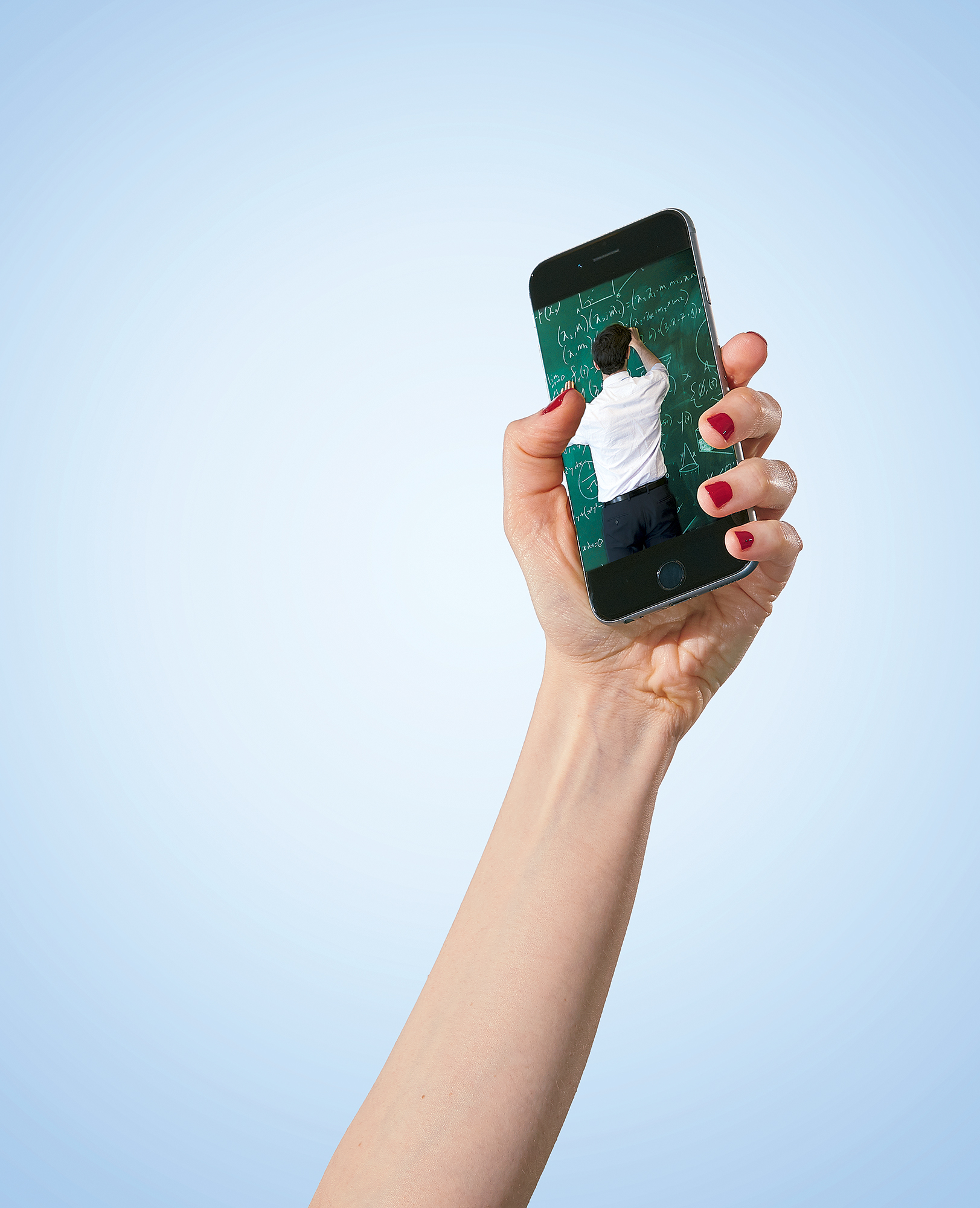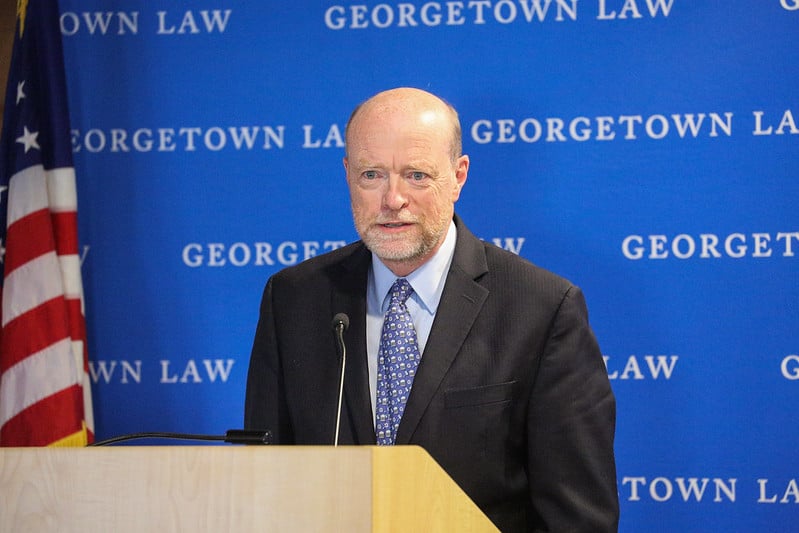What if PHDs lectured by Snapchat? The question isn’t so far-fetched. As the online world seeps into academia and people’s attention spans seem to shrink, educators are creating shorter, more interactive digital lessons that can be accessed anywhere, at any time, to grab students’ attention.
“The idea of sitting in a classroom for three hours now is dated,” says Kathryn Klose, dean of the University of Maryland University College Graduate School. “Learners can now reach out and find learning when and where they need it. It doesn’t need to take place in a seat in front of a professor.”
On a 20-minute bus or Metro ride, for example, a student could use a handheld device to read or listen to a brief passage—Klose calls it a “lecturette”—and then take a three-to-five-question quiz about the material. “You want this instruction to be digestible for them,” she says.
As a result, many online courses are now being designed as a series of brief sessions that can be conducted over a smartphone, tablet, or laptop. This allows students not only to study when and where they like but sometimes even to choose between the classroom and the internet.
That flexibility is increasingly important to schools because it helps them attract students who otherwise could be discouraged from pursuing higher education.
“The ‘nontraditional student’ used to be the reference for the adult student,” Klose says. “Now the nontraditional student is the typical student at all universities. They’re students of any age balancing school with other life commitments.”
A decade ago, online learning often was little more than a videotaped lecture or slide presentation on a website. Then MOOCs—or massive open online courses—hit the internet, allowing prominent professors to post lectures on a website and providing access to thousands of learners around the globe.
Interest in MOOCs surged around 2012. The novelty quickly faded, however, when schools found that only a small fraction of students signing up for online courses actually completed them.
“That is the main challenge—how do you keep people engaged?” says Ricardo Ernst, a business professor at Georgetown University. “You need to put the hooks in their mouths so the fish won’t go away.”
One way to reel them in, Ernst says, is to make sure online sessions are short. With a video, for example, a student’s attention starts to fade after about three to five minutes. So a two-hour online lecture can be counterproductive, he says.
The new model “flips” the classroom, changing the role of the instructor: “It’s asking the faculty to be less of the sage on the stage and to be more of a guide on the side.
A key to success with “micro-learning,” as it’s called, is to include opportunities to recap that series of brief, incremental lessons, whether through tests, group discussions, or projects. “There has to be some kind of culminating activity that would allow them to see how they would use what they learned in the real world,” Klose says.
Online instruction can be most effective when covering basic information such as standard concepts, Ernst explains. Different types of learners can move at their own pace and even repeat a lesson to ensure that they understand the material, unlike in a classroom, where there’s a risk of losing the attention of classmates who don’t need the repetition.
While some courses are online-only, instructors are also finding that internet learning can complement classroom instruction. That’s because offering some web instruction frees up classroom time for more interactive activities such as question-and-answer sessions, panel discussions, or work groups focused on applying the online material to real-life situations.
“You are creating more of a seminar environment,” Ernst says. “Therefore, the class time is more productive for all.”
Prior generations were assumed to be self-motivated—willing to sit for long periods and listen to a professor, Ernst says. But today students of all ages are conditioned to the quick images and information they see on the internet, and he believes educators should recognize this and employ those methods in their teaching.
Some educators caution that widespread and unfiltered use of digital lessons threatens to marginalize the role of the professor and to compromise the quality of education. Jonathan Rees and Jonathan Poritz, professors at Colorado State University–Pueblo, wrote a book titled Education Is Not an App: The Future of University Teaching in the Internet Age, in which they argue that faculty, not administrators, should have primary control over the online substance of their courses.

“Using the criterion of entertainment isn’t bad, but it should not be the first criterion,” Rees says. “The first criterion should be whether it meets the educational need, and the faculty member is in the best position to decide that.”
Rees serves on the national council of the American Association of University Professors but emphasizes that on this issue, he doesn’t speak on behalf of the association’s full membership. He’s “deeply suspicious” of blanket rules for online instruction—in some cases, a professor might decide that a longer video is an appropriate tool for teaching a subject. Rees also is concerned that administrators can make hasty decisions to launch online programs: “In the name of getting the program up fast, they will bypass faculty prerogatives.”
At Georgetown University’s School of Continuing Studies, Shenita Ray, director of online operations, oversees a team of instructional and graphic designers, videographers, technologists, and learning specialists to develop online classes. It takes about six months to create an online course from scratch, Ray says. A simple PowerPoint presentation doesn’t suffice: “That’s not a course. If you’re just putting text on the screen, you can go buy a book and learn it that way.”
At Georgetown’s SCS, the Social Impact Storytelling certificate, for example, is an online program that teaches students how to apply the power of storytelling to bring about change and accomplish goals. It’s broken into six segments of two or three weeks each. The final one, “Becoming a Story Changemaker,” requires students to complete a Pearson-Marr Achetype Indicator assessment, then to post a video on a discussion board in reaction to their PMAI assessment. A “voice thread” allows them to reply to a professor’s inquiries or another student’s comments by video message.
Whereas the old classroom model favors extroverts—those more comfortable speaking in class—the new one is more inclusive, supporting introverts as well, Ray says: “Online, you can’t be invisible. It demands that every single student has a voice and is participating.” Students also have more time to think. “We have much more thoughtful, deeper responses in the online space than I think people realize.
“It’s really the faculty engagement that makes the difference,” she adds. “You need to check in, literally, every day to see what’s going on with the class. You can’t go weeks without keeping in touch with them.”
Stephen Nodine, director of digital learning at George Mason University, agrees that student engagement online is higher: “There’s the opportunity for more participation for more of the students, and it’s more personalized and more self-directed.”
Instead of building large new lecture halls, George Mason has moved toward smaller classrooms with movable tables and seating that allow for greater interaction in person, too. “If we do it right, we take what we learn [online] and we change the way we teach in the classroom as well,” Nodine says.
Klose, of UMUC, explains that the new model “flips” the classroom, changing the fundamental role of the instructor: “It’s asking the faculty to be less of the sage on the stage and to be more of a guide on the side. When you’re a guide on the side, you’re a facilitator. You’re engaging students in active learning.”
For Klose, the new model puts a premium on instructors’ skills. “That’s where good teachers remain so valuable,” she says. “You can’t replace the human experience. We’re actually asking for more engagement and more one-on-ones with students and more nurturing and compassion and tough love sometimes, too.”
This article appears in the August 2018 issue of Washingtonian.
















